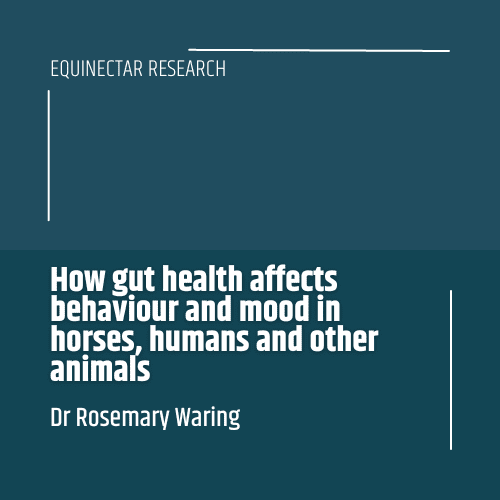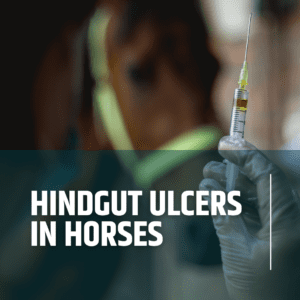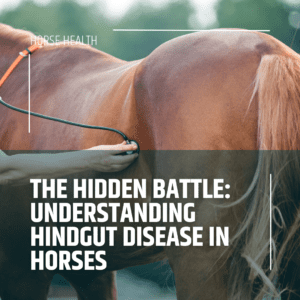Dr Rosemary Waring provides the following review looking at the impact of feeding EquiNectar on mood and behaviour.
Background
Research in both man and animals has suggested that there is a ‘gut/brain’ axis, where the gut microbiome can modulate the expression of mood and behaviour, altering the tendency to depression, anxiety and repetitive behavioural patterns (Ribeiro et al 2022). It is still unclear which mechanisms are involved although the effect appears to be multifactorial with input from generation of neurotransmitters by the gut microbiome, the altered synthesis of neurosteroids, the vagal nerve, immune function (Rogers et al 2016) and short-chain fatty acids (SCFAs, especially acetic, propionic and butyric acids) (O’Riordan et al 2022). SCFAs are formed by the action of gut bacteria on dietary fibre and are of considerable research interest as they have neuromodulator actions, particularly butyric acid which has been shown to have anti-inflammatory actions and to restore damaged gut walls. It also improves depressive or anxiety behaviour in mice (Cristiano et al 2022). The mechanism involved is not clear although it has been suggested that butyric acid may exert its effects by inhibition of histone deacetylase (Peng et al 2021). Other SCFAs may act similarly, as their administration to mice alleviates social stress and improves mood (van de Wouw et al 2018). As the microbiome can be changed by environmental influences, especially diet, research has focused on the interactions of food constituents and added probiotics with the enterobacterial profile and the metabolites which are generated.
In mammals, specific bacteria have been associated with patterns of behaviour. In mice, Blautia stercoris attenuated anxiety and repetitive behaviour (Sen et al 2022) while piglets fed on a fibrous diet (which increases SCFA levels) from day 2 had less stress and better growth while being less susceptible to diarrhoea. They also had more Prevotella and Ruminococcus spp. (Choudhury et al 2021). Pigs which were ‘tail biters’, attacking the tails of other pigs, also had a different microbiome from controls and lower levels of faecal butyric acid (Verbeek et al 2021). A similar effect was seen in hens where birds which pecked the feathers of other birds again had an altered microbiome with increased levels of Lactobacillus species (van Staaveren et al 2020).
In humans, studies have shown associations with behaviour and particular bacterial species. Taxa from butyrate-producers such as Lachnospiraceae and Ruminococcaceae were more prevalent in faecal samples from mothers in the 3rd trimester of pregnancy who went on to have children with normal behaviour at the age of 24 months as compared with those with children with behavioural problems at the same age. Babies with less Prevotella at the age of 12 months had worse behaviour at 24 months, suggesting long term effects (Dawson et al 2021). The influence of the gut microbiome extends to modulation of physical dexterity as infants with better fine motor skills at 18 months had more Collinsella, Coprococcus, Enterococcus, Fusobacterium, Holdemanella, Propionibacterium, Roseburia and Veillonella with less Turicibacter and Parabacteroides (Acuna et al 2021).
There is therefore clear evidence in several species showing that the gut microbiome can affect behaviour; as these bacterial species can be altered by environmental influences, especially diet, this is a major area of interest, particularly for equines. Stereotypic behaviours such as crib biting and wind sucking are relatively common in horses kept under sub-optimal stabling conditions and are believed to be a response to stresses which may be dietary or environmental (Sarrafchi and Blokhuis 2013). Horses have relatively low levels of amylases, the chief enzymes which break down starch, so that if they are fed large amounts of starch, much of this reaches the lower bowel where it is fermented by pathogenic bacteria. This results in increased permeability of the gut wall and increased production of toxic metabolites with hind gut acidosis. High starch diets are known to be linked with behavioural problems in horses, presumably because the dysbiosis leads to gut discomfort. Alterations in mood and responses also occur – horses fed a high-starch diet had increases in amylolytic and lactate-utilising bacteria which correlated with behavioural stress responses (Destrez et al 2015). A study using 185 horses found that stereotypical behaviour, hypervigilance and aggressiveness was associated with the microbiome profile (Mach et al 2020). The same researchers found that horses kept on pasture had an increase in Ruminococcus and Coprococcus which was associated with reduced stress while withdrawn behaviour was associated with increases in Lachnospiraceae AC2044 and the Clostridiales family XIII (Mach et al 2021). Trigeminal-mediated headshaking was linked with the presence of Methanocorpusculum spp (Aleman et al 2022). Increases in Lactobacillus appear to reflect increases in lactic acid production which is a biomarker for gut dysbiosis. In agreement with this, horses with laminitis derived from oligosaccharide treatment had a lower faecal pH and higher levels of lactic acid, histamine and LPS in the serum. These markers of inflammation were associated with more Lactobacillus and Megasphaera in the microbiome (Tuniyazi et al 2021); studies in other species have linked high levels of Lactobacillus with non-optimal behavioural changes suggesting that inflammatory states in the gut may be associated with altered brain function (Barrio et al 2022; van Staaveren et al 2020).
Results from all species studied, including man, therefore support the view that the gut bacteria profile can exert modulatory effects on brain function and behaviour. In turn, this suggests that dietary supplements that can re-balance the microbiome may influence behavioural responses. We used ERME (Enzyme-Rich Malt Extract, formulated as ‘Equinectar’ for horses and ‘Juvia’ for human subjects) as a dietary supplement; this contains enzymes to improve starch digestion and reduce the amount of polysaccharide reaching the lower bowel for fermentation. The alteration in substrate provision modulates the microbiome with a reduction in inflammation. Butyrogenic bacterial species become more abundant, and this gives increased provision of butyrate with other short-chain fatty acids. Although the total metagenomic and metabolomic picture was complex, we discovered a consistent pattern (Table 1). In human athletes there was an increased abundance of Ruminococcus and Blautia, with higher levels of SCFAs. Similar profiles were seen in racing pigeons and racehorses, consistent with earlier findings (Proudman et al 2014). Adding ERME to the diet should therefore give a calmer and less-stressed horse, as has been found in the many feeding trials that have been conducted. It could also be beneficial for human and avian athletes.
Table 1
| Microbiome alteration after ERME supplementation | Metabolome alteration after ERME supplementation | |
| Humans | Increases in Ruminococcus, Blautia | Increases in total SCFAs |
| Racehorses | Increases in Ruminococcus | Increases in butyric acid |
| Racing Pigeons | Increases in Ruminococcus | Increases in butyric acid |
References
1. Acuna I et al 2021 Nutrients 13 (5) May 14
2.Aleman M et al 2022 Vet Medicine and Science 8(3):1049-1055 05
3.Barrio C et al 2022 Psychoneuroendocrinology 137:105640 03
4.Cristiano C et al 2022 Biomed. and Pharmacother. 153:113528 Sept
5.Dawson SL et al 2021 EBiomedicine 68:103400 Jun
6.Destrez A et al 2015 Physiology and Behaviour 149 159-164
7.Mach N et al 2020 Scientific Reports 10(1):8311 05 20
8.Mach N et al 2021 Scientific Reports 11(1): 5007 03 03
9.O’Riordan KJ et al 2022 Molecular and Cellular Endocrinology 546: 111572 04 15
10.Peng L et al 2021 Neurochemical Research 46(9):2333-2347 Sept.
11.Proudman CJ et al 2014 Equine Vet J 10.1111 12324
12.Ribeiro G et al 2022 Current Opinion in Clinical Nutrition and Metabolic Care 25(6) 443-450 11 01
13.Rogers GB et al 2016 Molecular Psychiatry 21 738-748
14.Sarrafchi A and Blokhuis HJ 2013 J Vet Behaviour 8 386-394
15.Sen P 2022 Brain Behaviour and Immunity 106: 115-126 11
16.Tuniyazi M et al 2021 BMC Vet Res 17(1): 11 Jan 06
17.van de Wouw M et al 2018 J Physiol. 596(20):4923-4944
18.Van Staaveren N et al 2020 Scientific reports 10(1):12978 07 31
19.Verbeek E et al 2021 Scientific Reports 11(1):20547 10 15





